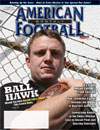Article CategoriesAFM Magazine
|
No Pipes and No Posts - Protecting the Middleby: Mike KucharSenior Writer, American Football Monthly © More from this issue Every coverage has its strengths and its weaknesses. The key to any productive defense lies in when to mix and match coverages based on personnel, down and distance and run/pass tendencies. The strength of the quarters coverage, or cover four scheme, has been synonymous with stopping the run because of the availability of tying in both safeties at the point of attack, giving the defense nine defenders in the box. Many even-front teams have been using the coverage against pro and slot formations in order to get more hats than the offense can block. But the weakness of the coverage continues to be defending the pass game, particularly the play-action schemes, and leveraging flat routes. Many quarters disciples teach their safeties to commit hard to the run once they recognize it, but many offenses have found that a companion play-action ....The full article can only be seen by subscribers.
|
|
|||||||
| HOME |
MAGAZINE |
SUBSCRIBE | ONLINE COLUMNISTS | COACHING VIDEOS |
Copyright 2025, AmericanFootballMonthly.com
All Rights Reserved





